1.14 TCP/IP WEB NET Server SDCard FATFS
The Web Net Server SD Card application demonstrates creating an HTTP web server on a Microchip evaluation board. The FAT FS File System is used for storing the web pages on an external SD Card.
This demonstration uses the HTTPNET server module that supports encrypted communication with NET_PRES layer and third-party TLS service provider (like wolfSSL).
Description
The TCP/IP WEB NET Server SDCard FATFS application is based on MPLAB® Harmony 3 TCP/IP Stack.
The Harmony TCP/IP stack is a collection of different network protocols.
The source files of Harmony 3 TCP/IP stack is available here.
The demo is created with MPLAB X IDE and MCC plugin.
MCC Project Graph - TCP/IP WEB NET Server SDCard FATFS
The following Project Graph shows the Harmony components included in the TCP/IP WEB NET Server SDCard FATFS demo application.
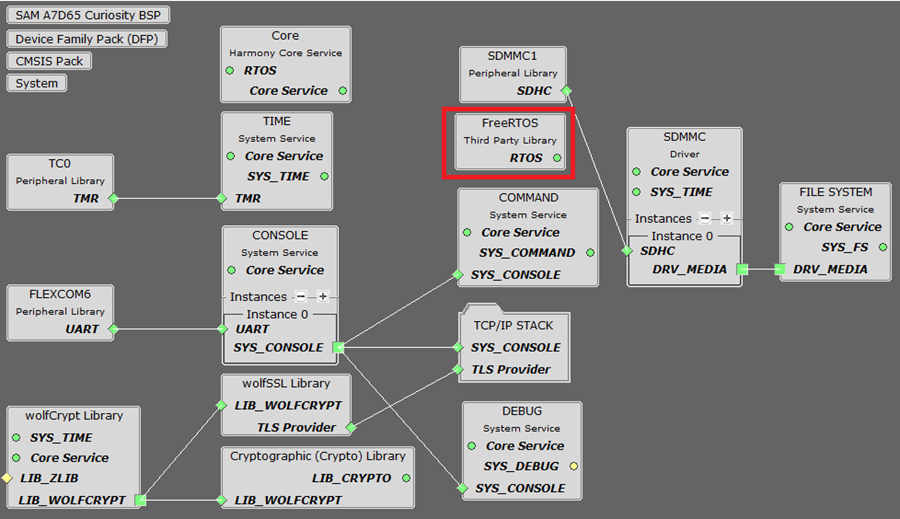
FreeRTOS component is required for RTOS application. For bare-metal (non-RTOS) FreeRTOS component should not be selected.
wolfSSL component is added for secure connection which supports TLS.
wolfCrypt module enabled with MD5 and SHA authentication
FILE SYSTEM is added to read and write from the SDMMC( sdcard ) module with FAT file system.
TCP/IP Configuration - TCP/IP WEB NET Server SDCard FATFS
The TCP/IP modules enabled for the demo is shown in the TCP/IP Configuration Overview
More details of TCP/IP Configuration plugin is available here
The Ethernet interface in this demo-configuration use GMAC0 with Onboard Gigabit Ethernet PHY Transceiver LAN8840.
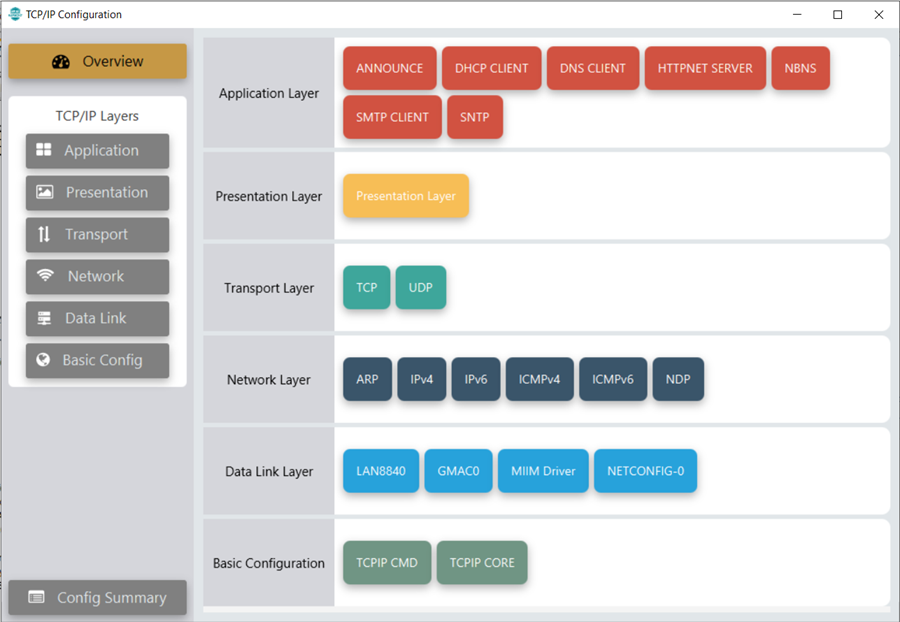
The Ethernet interface in this demo-configuration use GMAC1 with External Gigabit Ethernet PHY Transceiver LAN8840.
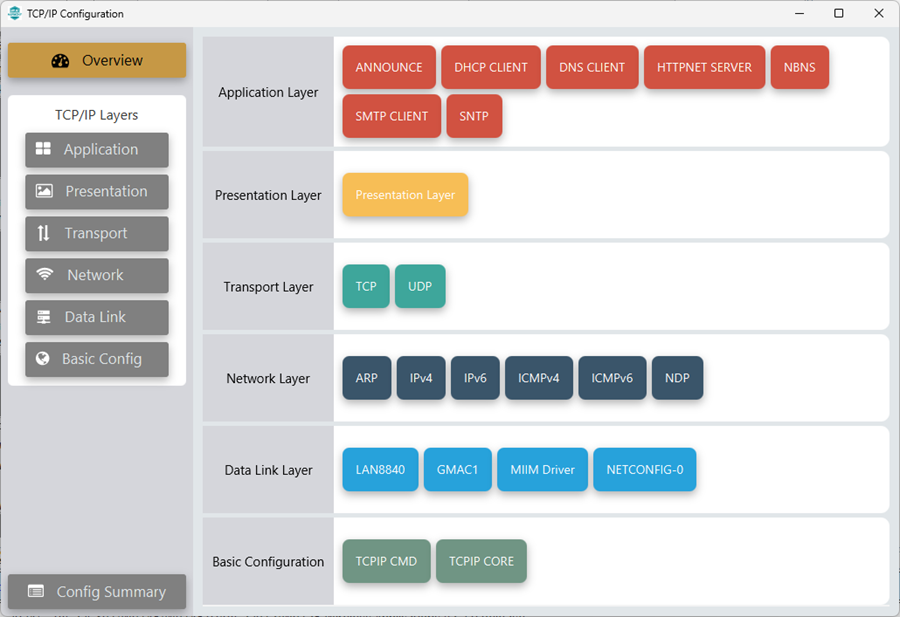
The Application Layer modules enabled in the demo are as follows:
- Application Layer Modules
- ANNOUNCE to discover the Microchip devices within a local network.
- DHCP Client to discover the IPv4 address from the nearest DHCP Server.
- DNS Client provides DNS resolution capabilities to the stack.
- HTTPNET SERVER enables the target board to act as a Web Server for the secured port number 443.
- NBNS NetBIOS Name Service protocol associates host names with IP addresses. This assign of human-name host names to access boards on the same subnet.
- SMTP CLIENT let applications send e-mails to any recipient worldwide.
- SNTP Simple Network Time Protocol updates its internal time periodically using a pool of public global time servers.
Downloading and Building the application
To clone or download this application from Github, go to the main page of this repository and then click Clone button to clone this repository or download as zip file.
This content can also be downloaded using content manager by following these instructions.
Path of the application within the repository is apps\web_net_server_sdcard_fatfs\ .
To build the application, refer to the following list of demo configurations and open the project using MPLAB X IDE.
| Project Name | Target Device | Development Board | Description |
|---|---|---|---|
| sam_a7d65_curiosity_gmac0.X | SAMA7D65 | SAMA7D65-Curiosity | TCP/IP WEB NET Server SDCard FATFS - Onboard Gigabit Ethernet PHY LAN8840 - Bare Metal |
| sam_a7d65_curiosity_gmac0_freertos.X | SAMA7D65 | SAMA7D65-Curiosity | TCP/IP WEB NET Server SDCard FATFS - Onboard Gigabit Ethernet PHY LAN8840 - FreeRTOS |
| sam_a7d65_curiosity_gmac1.X | SAMA7D65 | SAMA7D65-Curiosity+ LAN8840 EDS2 Daughter Card | TCP/IP WEB NET Server SDCard FATFS - External Gigabit Ethernet PHY LAN8840 - Bare Metal |
| sam_a7d65_curiosity_gmac1_freertos.X | SAMA7D65 | SAMA7D65-Curiosity+ LAN8840 EDS2 Daughter Card | TCP/IP WEB NET Server SDCard FATFS - External Gigabit Ethernet PHY LAN8840 - FreeRTOS |
Hardware Setup - SAMA7D65-Curiosity
The target board for running the application is SAMA7D65-Curiosity.
This section provides essential hardware configuration of this target board to run TCP/IP applications.

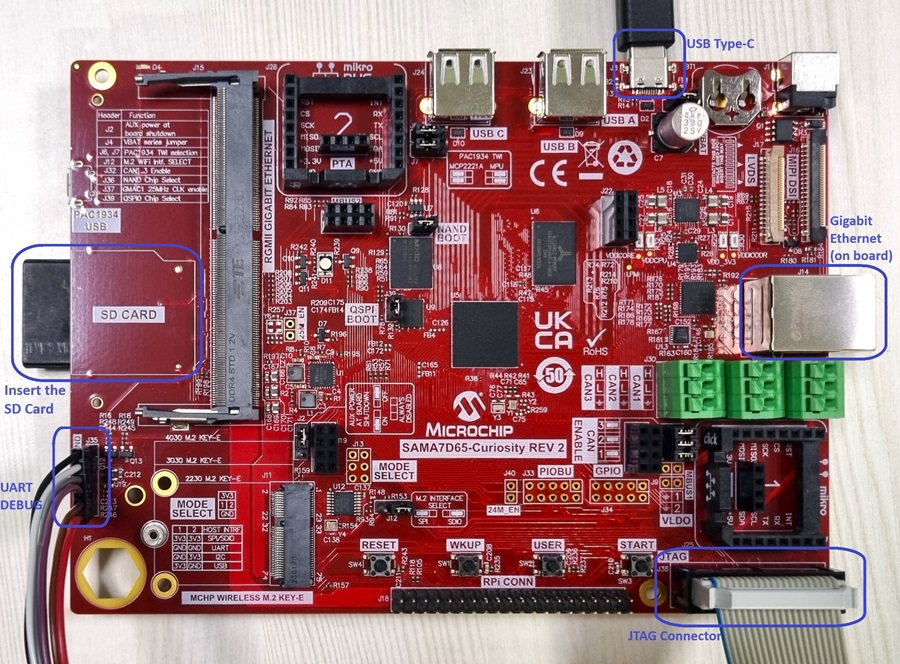
Board Setup
To set up the hardware, refer to the section Board Setup in SAMA7D65-Curiosity Kit User Guide.
- Default jumper setting of the board is shown above.
- Connect the USB Type-C cable between USB-A port on the board and host PC. This will supply power to the board.
- Connect a USB-UART converter for console output between the UART DEBUG port on the board and host PC.
- Connect the debugger/programmer between JTAG connector on the board and host PC.
- Insert a microSD card with SD adapter into the SD Card connector(which is on backside of the board) as shown above .
- For GMAC0 application demos, connect Ethernet cable between RJ45 connector of Onboard Gigabit Ethernet PHY LAN8840 and router/switch/computer.
- For GMAC1 application demos, connect Ethernet cable between RJ45 connector of External Gigabit Ethernet PHY LAN8840 (through SODIMM add-on slot) and router/switch/computer.
Setting up at91bootstrap loader
To load the application binary onto the target device, we need to use at91bootstrap loader.
Refer to the at91bootstrap loader documentation for details on how to configure and run/debug the application using MPLABX and booting application using an SD Card.
Running the Application
- Open a terminal application on the host computer (like Hyper-terminal or Tera Term).
- Configure the terminal application for serial port connected to UART DEBUG port.
- Set baud rate as 115200 in the terminal application.
- Build and download the application project on the target board.
- Ensure connection from Gigabit(1000Mbps) capable network socket of a router/switch/computer to the board.
- Ensure SD card is formatted and loaded with the web pages provided within the /net_apps_sama7d6/apps/web_net_server_sdcard_fatfs/src/web_pages directory.
- Insert SD Card to its slot on target board.
- Verify the TCP/IP Stack initialization console messages.
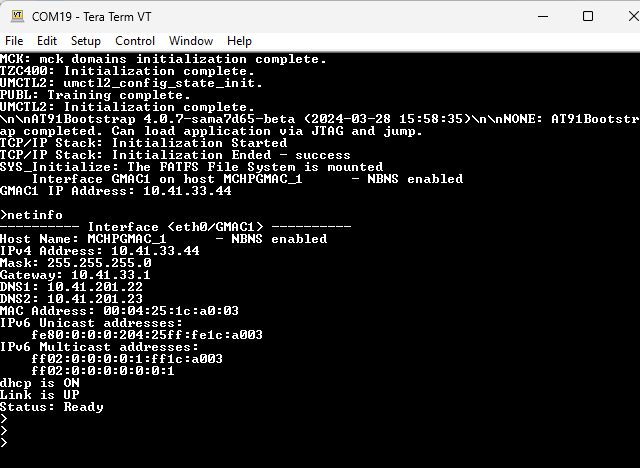
If DHCP client is enabled in the demonstration, wait for the DHCP server to assign an IP address for the development board.
This will be printed on the console. Otherwise, the default static IP address will be assigned to the board.
By entering the command netinfo, the response is obtained as shown above.
Web Server Test
- Open a web browser (like Google Chrome, etc).
- Type the board URL in the address bar of web browser (for example, https://mchpgmac_1 or https://<ip-address as shown in the console> ).
- The web browser display following web page
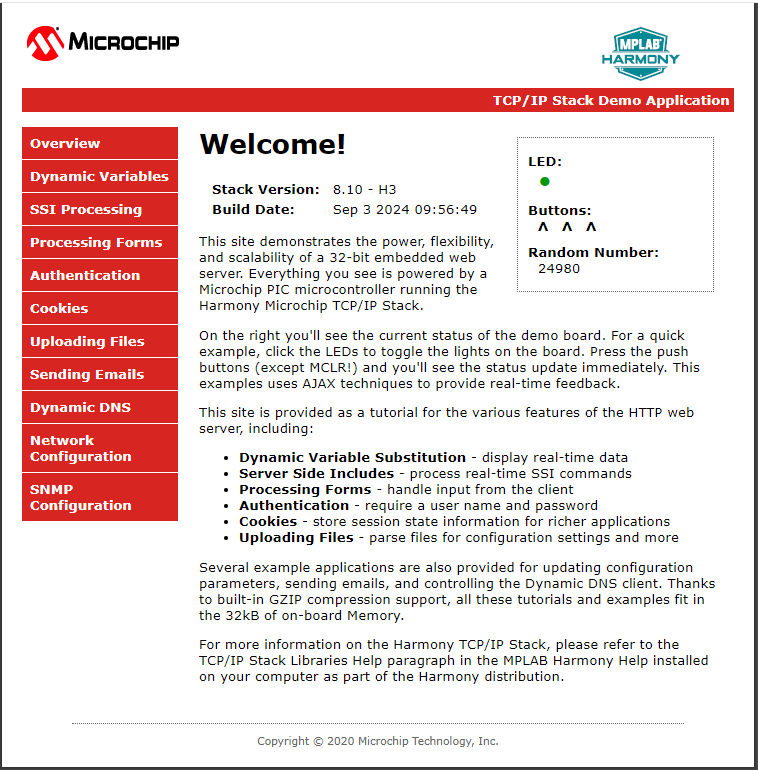
Application features are:
- Dynamic Variables and Real-time Hardware Control - Pressing Switches on target board toggles buttons on web page. Similarly, Clicking on LED symbol in web page can toggle LEDs on target board.
- Form Processing - Input can be handled from the client by the GET and POST methods.
- Authentication - Shows an example of the commonly used restricted access feature.
- Cookies - Shows an example of storing small text strings on the client side.
- Server Side Includes - An example of how SSI can be used to support dynamic content.
- File Uploads - Shows an example of a file upload using the POST method. The HTTP server can accepta user-defined MPFS/MPFS2 image file for web pages.
- Send E-mail - Shows simple SMTP POST methods
- Dynamic DNS - Exercises Dynamic DNS capabilities
- Network Configuration - The MAC address, host name, and IP address of the evaluation kit can be viewed in the Network Configuration page and some configurations can be updated
- MPFS Upload - A new set of web pages can be uploaded to the web server using this feature, which is accessed through http://mchpgmac_1/mpfsupload
Note: For the LED and SWITCH demo functionality, configure the GPIOs connected to LEDs and Switches on target development board, through the Pin Configuration manager in MCC.
